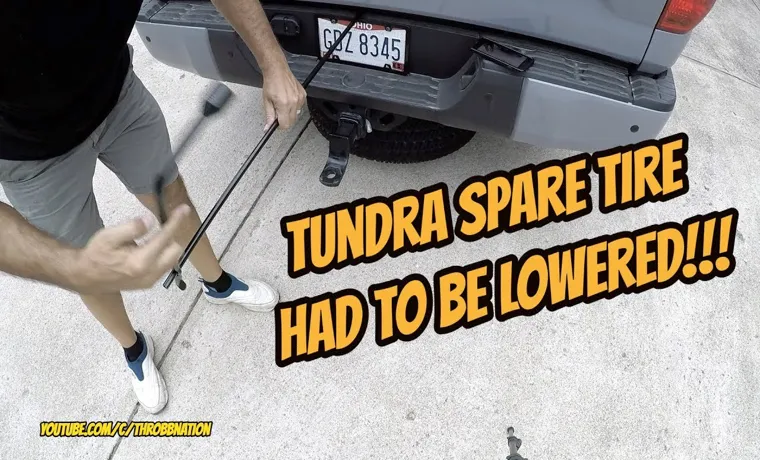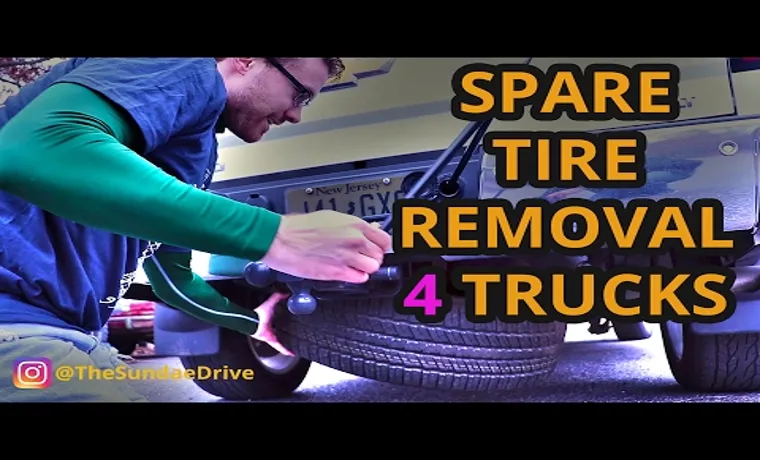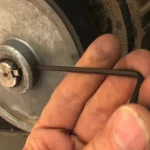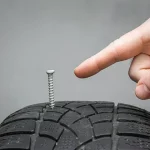Are you tired of lugging around a heavy spare tire in your car? Not only does it take up valuable space, but it can also affect your vehicle’s fuel efficiency and handling. Fortunately, lowering your spare tire is a simple process that can be done in just a few steps. In this step-by-step guide, we’ll show you exactly how to lower your spare tire safely and easily.
We’ll cover the tools you’ll need, the precautions you should take, and the exact steps you’ll need to follow. So grab your lug wrench and let’s get started!
Table of Contents
Locating Your Spare Tire
Are you stuck with a flat tire and need to locate your spare tire? Don’t worry; we have you covered. First, find the spare tire’s location; it could be in the trunk, backdoor, or underneath the car. If the spare tire is underneath, check your vehicle’s manual to identify the location of the jack and how to access it.
Once you’ve located the jack, engage the emergency brake and use the jack to raise the car slightly off the ground. Then, use a wrench to loosen the lug nuts, remove them, and slide the flat tire off. Finally, place the spare tire on and tighten the lug nuts back on firmly before lowering the car back down.
You’re done, and back on the road!
Check your owner’s manual for the tire’s location
If you’re driving a car that was manufactured in the last several years, it likely comes equipped with a spare tire. However, locating that tire may not be as straightforward as you think. The spare tire could be located in a variety of places, depending on the make and model of your vehicle.
The best way to find out where your spare tire is located is to check your owner’s manual. Your owner’s manual will provide detailed information on where the spare tire is stored and how to access it in case of a flat tire. It’s important to keep in mind that not all cars come with a spare tire.
Some may have a tire repair kit instead, which can be used to temporarily fix a flat tire. It’s always a good idea to familiarize yourself with your vehicle’s tire situation so that you’re not caught off guard in the event of a flat tire.

It’s usually found in the trunk or under the vehicle
If you’ve ever had a flat tire while driving, you know how important it is to have a spare tire handy. But where is it, exactly? Typically, spare tires are located either in the trunk of the car or underneath the vehicle. In sedans and smaller cars, it is usually found in the trunk, sometimes underneath the carpet.
If it’s not in the trunk, you may need to check under the car. SUVs and pickup trucks, for example, tend to keep the spare tire somewhere on the underside of the vehicle. However, if you’re unsure about where your spare tire is, you can always refer to your owner’s manual or consult with a professional.
It’s important to note that no matter where your spare tire is located, it should be checked regularly to ensure it’s in proper condition and ready to use when you need it.
Finding the Spare Tire Tools
If you’re like most people, the spare tire in your vehicle probably doesn’t get a whole lot of attention. However, when you do need it, you’ll be glad it’s there. The problem is, many people have trouble figuring out how to get their spare tire down from its storage location.
The first thing you’ll need to do is find your spare tire tools. These are usually located in the trunk of your car, or under the rear cargo area in an SUV. Depending on your vehicle, these tools may include a lug wrench, a jack, and a tire iron.
Once you’ve located your tools, you’ll need to use them to lower the spare tire from its storage location. This can usually be done by inserting the tire iron into a designated hole and rotating it counterclockwise. As you do this, the spare tire will begin to lower to the ground.
Once it’s fully extended, you can remove it from its storage location and install it on your vehicle. Remember to always check the air pressure in your spare tire before hitting the road.
Look for a lug wrench and a jack
When you’ve found yourself with a flat tire, one of the first things you should do is look for the spare tire and the necessary tools to change it. Typically, the spare tire is located in the trunk of your car, but finding the lug wrench and jack can be a bit more tricky. The lug wrench is used to loosen and remove the lug nuts that hold the flat tire in place, while the jack raises the car off the ground to allow for the tire to be changed.
These tools may be hidden in the spare tire compartment or stored elsewhere in the vehicle. Start by checking in the trunk for a bag or compartment specific for the tools. If they’re not there, check under seats, under floor mats, or in the glove compartment.
It’s essential to locate these tools before hitting the road, so you can quickly and safely change a flat tire if necessary.
These will be needed to lower the tire
If you find yourself with a flat tire, you’ll need to lower it to replace it with a spare. That means you need to have the right tools on hand. Most vehicles come with a spare tire, jack, and lug wrench in case of emergencies.
However, before you can change your tire, you need to find these essential items. First, look in your trunk or under the back of your car to locate the spare tire. Next, check for a jack and lug wrench.
The jack is used to lift the car while the lug wrench is used to remove the lug nuts holding the damaged tire in place. If you can’t find these tools, check your car’s manual or contact your dealership to get the right equipment. Remember, having the correct tools will ensure that you can change your tire safely and efficiently without any accidents.
So, the next time you’re out on the road, make sure you have all the necessary tools to handle a flat tire emergency.
Removing the Spare Tire Cover
If you ever find yourself in a situation where you need to use your spare tire, it’s important to know how to get it down from its hiding place. The first step is to remove the spare tire cover, which is typically located on the back of SUVs or underneath trucks. To do this, check for any screws or clips that are holding it in place, and then simply pry it off.
Once the cover is removed, you should be able to locate the spare tire and its hoist mechanism. Use the jack handle to turn the crank of the hoist mechanism counterclockwise, which will lower the tire to the ground. Be sure to keep a firm grip on the tire as it comes down, and carefully detach it from the hoist once it’s reached the ground.
With a little bit of know-how and some elbow grease, removing the spare tire cover and getting to your spare tire can be a quick and easy process.
Sometimes a screwdriver is needed to pry it off
Removing the spare tire cover can be a frustrating task, especially if it’s stuck on tightly to the spare tire. Sometimes a screwdriver is needed to pry it off. To remove the cover, you need to locate the latch or fastener that is holding it in place.
It is usually located on the underside of the cover or near the center of the cover. Once you have found the latch, you need to release it. If it’s a screw, you will need to use a screwdriver to loosen it.
After the latch has been released, you can then pull the cover off. If the cover is stuck, you can try gently pulling it off. However, if it’s still stuck, you can use a screwdriver to gently pry it off.
It’s important to be careful not to damage the tire or the cover while doing this. Overall, removing the spare tire cover may require a little elbow grease, but with a little patience and the right tools, it shouldn’t be too much of a hassle.
Be careful not to damage the cover or tire itself
When it comes to changing a flat tire, one crucial step is removing the spare tire cover. However, it’s essential to be careful not to damage the cover or tire itself in the process. Before attempting to remove the cover, loosen the lug nuts on the flat tire, then lift the cover from the center.
Be gentle as you lift it to avoid putting too much pressure on any one spot. If the cover is tight, use a flathead screwdriver to pry it gently from the tire’s edges. Avoid using excessive force, as this can cause the tire cover to crack.
Remember, the spare tire cover is designed to protect your spare tire from debris and weathering, so it’s essential to handle it with care to ensure it lasts as long as possible. By being mindful and taking your time, you’ll remove the spare tire cover without damaging it or your tire.
Lowering the Spare Tire
If you’ve ever found yourself with a flat tire on the side of the road, you know how important it is to have a spare tire ready and waiting. But what do you do if you can’t seem to get your spare tire down from its hiding spot? First, check your owner’s manual for specific instructions on how to lower the tire on your make and model of vehicle. In general, though, you’ll likely need to access your spare tire winch, which is usually located underneath the back of your vehicle.
Once you locate the winch, use the standard lug wrench to turn the crank and lower your spare tire to the ground. If you’re still having trouble, try applying a penetrating oil to the winch to help loosen it up. Remember to always use caution when working with your vehicle and to seek professional help if you’re unsure of what to do.
Insert the wrench into the hoist mechanism and turn it counterclockwise
If you find yourself with a flat tire and need to make the switch to your spare, it’s essential to know how to lower the spare tire down from under your vehicle. Luckily, it’s a simple process that can be done in just a few easy steps. Begin by locating the hoist mechanism usually found towards the rear of the vehicle beneath the trunk.
Once you’ve found it, insert the wrench that came with your car’s jack and turn it counterclockwise. As you do this, the spare tire should start to lower down slowly. To ensure complete safety, we recommend double-checking that your vehicle is on a level surface before attempting to lower the spare tire.
In case of any confusion, the hoist mechanism should have simple diagrams and instructions imprinted on it. Keeping your wrench and spare tire in a secure place in your vehicle can prevent any mishaps in the event of a tire emergency. Knowing how to lower your spare tire can save you time, money, and stress, making the whole process a little less daunting.
Continue until the tire is fully lowered
When faced with a flat tire, it’s essential to know how to change it. Lowering the spare tire is one of the essential steps in this process. To do this, locate the jack and the tire wrench in your vehicle’s trunk.
The wrench will help you remove the lug nuts that keep the flat tire in place. Once you’ve loosened the nuts, position the jack under the vehicle and raise the car until the flat tire is in the air. This way, you can easily remove the tire.
With the flat tire off, insert the spare tire onto the studs and hand tighten the lug nuts. Then, continue to lower the car with the jack until the tire touches the ground. Using the wrench, tighten the lug nuts as much as possible in a star or cross pattern.
Finally, lower the jack completely, and your vehicle is ready to go. Just remember to have the flat tire repaired or replaced as soon as possible. It’s crucial to ensure your safety while driving on the road.
Removing the Spare Tire
One of the most frustrating experiences for drivers is getting a flat tire and realizing that the spare tire is stuck in the carrier underneath the vehicle. If you’re wondering how to get your spare tire down, don’t worry, it’s a simple process. First, locate the tools needed to lower the tire, typically located in the trunk or under the back seat.
Once you have the tire iron and jack handle, insert the tire iron into the hole located in the bumper or under the trunk. Turn the wrench clockwise to release the spare tire from the carrier, and lower it gently to the ground. Be sure to check the tire’s air pressure before installing it.
If you’re unsure of how to reinstall the spare tire, refer to your vehicle’s user manual for instructions. With this simple process, you can remove and reinstall the spare tire in no time, getting you back on the road and on with your journey.
Use the lug wrench to remove the bolts holding the tire in place
When you find yourself with a flat tire, you’ll want to have the spare tire on hand and ready to use. Removing the spare tire is a straightforward process, and by following these steps, you’ll be back on the road in no time. First, locate the lug wrench and use it to loosen the bolts holding the tire in place.
Don’t remove them just yet – instead, use the wrench to break them free. Next, use the jack to lift the vehicle off the ground, positioning it securely under the recommended jacking point. When the vehicle is raised to a safe height, you can use the lug wrench to fully remove the bolts and take the tire off.
Be sure to keep the lug nuts in a safe place so you can easily locate them when you’re ready to put the spare tire on. With the old tire off, you’re now ready to replace it with the spare – but that’s a topic for another time. Remember the keyword for this process – lug wrench – and keep it handy for any future flat tires that may come your way.
Set the tire on the ground and replace with the flat tire
After successfully changing your tire, it’s time to put away the spare tire and get back on the road. Start by removing the spare tire from under your vehicle. Most cars have spare tires secured to the car’s underside, so you need to use a tire iron to loosen the bolts holding the tire in place.
Once you’ve dislodged the spare tire, slowly lower it to the ground by cranking the winch. Next, remove the flat tire from the car and set it aside. Don’t forget to retrieve your jack and lug wrench too.
Once the flat tire is out of the picture, you can now put the tire on the ground and re-tighten the bolts to secure it properly. Before you start driving, test the inflation pressure of your new tire using a tire gauge to make sure it’s inflated to the manufacturer’s recommended PSI. With the spare tire out of the way and your vehicle back in action, you can confidently continue your journey knowing that you handled the situation like a pro.
Conclusion
In conclusion, getting your spare tire down is like trying to find your keys in the dark – frustrating and confusing. But fear not, with a bit of patience and determination, you can conquer this daunting task. Just remember to locate the tire tools, follow the instructions in your car manual, and give the mechanism a good jolt to free the tire.
And if all else fails, just call a friend who is handy with a wrench or a tow truck to save the day. Happy tire-changing adventures!”
By following these steps, you can easily lower and change your spare tire.
Lowering and changing a spare tire can be a daunting and intimidating task for many drivers. However, it is a necessary skill to have in case of a flat tire or other emergency. The first step in removing the spare tire is to locate it in your vehicle.
Typically, spare tires are found in the trunk or mounted underneath the rear of the car. Once you have located the tire, you will need to retrieve the necessary tools. These typically include a jack, lug wrench, and possibly a wheel chock.
Next, you will need to position the jack underneath the car in the correct location, which can typically be found in your vehicle’s owner’s manual. Then, using the lug wrench, loosen the lug nuts on the tire you need to change. Once the lug nuts are loose, place the jack in the correct position and begin to jack up the car until the tire is off the ground.
Finally, remove the lug nuts completely and carefully remove the tire from the car. By following these steps, you can easily lower and change your spare tire with confidence.
FAQs
How do I access the spare tire in my car?
To access the spare tire, find the crank mechanism in your trunk or undercarriage. Insert the crank and turn it until the tire is lowered to the ground.
Can I change a flat tire on my own?
Yes, changing a flat tire is a relatively simple process. Just be sure to follow the steps carefully and use proper safety precautions.
What tools do I need to change a tire?
You will need a spare tire, a lug wrench, a jack, and a wheel chock. Some cars may also require a locking lug nut key.
How often should I check my spare tire?
It is recommended that you check the pressure and condition of your spare tire at least once a year.
What should I do if my spare tire is flat?
If your spare tire is flat, you will need to inflate it before use. You can do this using a portable air compressor or by visiting a gas station with an air pump.
How long can I drive on a spare tire?
Spare tires are designed for temporary use only and should not be driven on for more than 70 miles or at speeds over 50 mph.
Can I replace my spare tire with a full-size tire?
Yes, it is recommended to replace your spare tire with a full-size tire as soon as possible, especially if you plan on driving long distances.



